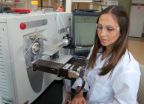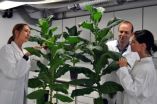(Press-News.org) One of the most difficult problems in the field of genomics is assembling relatively short "reads" of DNA into complete chromosomes. In a new paper published in Proceedings of the National Academy of Sciences an interdisciplinary group of genome and computer scientists has solved this problem, creating an algorithm that can rapidly create "virtual chromosomes" with no prior information about how the genome is organized.
The powerful DNA sequencing methods developed about 15 years ago, known as next generation sequencing (NGS) technologies, create thousands of short fragments. In species whose genetics has already been extensively studied, existing information can be used to organize and order the NGS fragments, rather like using a sketch of the complete picture as a guide to a jigsaw puzzle. But as genome scientists push into less-studied species, it becomes more difficult to finish the puzzle.
To solve this problem, a team led by Harris Lewin, distinguished professor of evolution and ecology and vice chancellor for research at the University of California, Davis and Jian Ma, assistant professor at the University of Illinois at Urbana-Champaign created a computer algorithm that uses the known chromosome organization of one or more known species and NGS information from a newly sequenced genome to create virtual chromosomes.
"We show for the first time that chromosomes can be assembled from NGS data without the aid of a preexisting genetic or physical map of the genome," Lewin said.
The new algorithm will be very useful for large-scale sequencing projects such as G10K, an effort to sequence 10,000 vertebrate genomes of which very few have a map, Lewin said.
"As we have shown previously, there is much to learn about phenotypic evolution from understanding how chromosomes are organized in one species relative to other species," he said.
The algorithm is called RACA (for reference-assisted chromosome assembly), co-developed by Jaebum Kim, now at Konkuk University, South Korea, and Denis Larkin of Aberystwyth University, Wales. Kim wrote the software tool which was evaluated using simulated data, standardized reference genome datasets as well as a primary NGS assembly of the newly sequenced Tibetan antelope genome generated by BGI (Shenzhen, China) in collaboration with Professor Ri-Li Ge at Qinghai University, China. Larkin led the experimental validation, in collaboration with scientists at BGI, proving that predictions of chromosome organization were highly accurate.
Ma said that the new RACA algorithm will perform even better as developing NGS technologies produce longer reads of DNA sequence.
"Even with what is expected from the newest generation of sequencers, complete chromosome assemblies will always be a difficult technical issue, especially for complex genomes. RACA predictions address this problem and can be incorporated into current NGS assembly pipelines," Ma said.
###
Additional coauthors on the paper are Qingle Cai, Asan, Yongfen Zhang, and Guojie Zhang, BGI-Shenzhen, China; Loretta Auvil and Boris Capitanu, University of Illinois Urbana-Champaign.
The work was supported by grants from the National Science Foundation, National Institutes of Health, U.S. Department of Agriculture, National Research Foundation of Korea, Polish Grid Infrastructure Project, National Basic Research Program of China, Program of International S&T Cooperation of China and the National Natural Science Foundation of China.
Solving puzzles without a picture
New algorithm assembles chromosomes from next generation sequencing data
2013-01-10
ELSE PRESS RELEASES FROM THIS DATE:
Marriage linked to better survival in middle age
2013-01-10
Could marriage, and associated companionship, be one key to a longer life? According to new research, not having a permanent partner, or spouse, during midlife is linked to a higher risk of premature death during those midlife years. The work, by Dr. Ilene Siegler and colleagues from Duke University Medical Center in the US, is published online in Springer's journal Annals of Behavioral Medicine.
Survival through middle age to become elderly is expected; therefore understanding who does not survive to become elderly and why is important. Siegler and colleagues looked ...
Banded mongooses structure monosyllabic sounds in a similar way to humans
2013-01-10
This press release is available in German.
Animals are more eloquent than previously assumed. Even the monosyllabic call of the banded mongoose is structured and thus comparable with the vowel and consonant system of human speech. Behavioral biologists from the University of Zurich have thus become the first to demonstrate that animals communicate with even smaller sound units than syllables.
When humans speak, they structure individual syllables with the aid of vowels and consonants. Due to their anatomy, animals can only produce a limited number of distinguishable ...
New report: The reach and impact of mathematical sciences
2013-01-10
The Mathematical Sciences in 2025, a new report from the National Research Council, finds that the mathematical sciences are an increasingly integral component of many disciplines -- including biology, medicine, the social sciences, business, advanced design, and climate studies. However, the expanding role of the mathematical sciences over the past 15 years has not been matched by a comparable increase in federal funding, and the number of federal agencies that provide significant support for this research is considerably smaller than the number that profit from it.
The ...
Is there a period of increased vulnerability for repeat traumatic brain injury?
2013-01-10
New Rochelle, NY, January 10, 2013—Repeat traumatic brain injury affects a subgroup of the 3.5 million people who suffer head trauma each year. Even a mild repeat TBI that occurs when the brain is still recovering from an initial injury can result in poorer outcomes, especially in children and young adults. A metabolic marker that could serve as the basis for new mild TBI vulnerability guidelines is described in an article in Journal of Neurotrauma, a peer-reviewed journal from Mary Ann Liebert, Inc., publishers. The article is available free on the Journal of Neurotrauma ...
New tool to help brain surgeons 1 step closer to operating room
2013-01-10
WEST LAFAYETTE, Ind. - A new tool that could allow for faster, more comprehensive testing of brain tissue during surgery successfully identified the cancer type, grade and tumor margins in five brain surgery patients, according to a Purdue University and Brigham and Women's Hospital study.
The tool sprays a microscopic stream of charged solvent onto the tissue surface to gather information about its molecular makeup and produces a color-coded image that reveals the nature and concentration of tumor cells.
Researchers analyzed specimens removed from the patients, but ...
Scientists design, control movements of molecular motor
2013-01-10
ATHENS, Ohio (Jan. 10, 2013)—An international team of scientists has taken the next step in creating nanoscale machines by designing a multi-component molecular motor that can be moved clockwise and counterclockwise.
Although researchers can rotate or switch individual molecules on and off, the new study is the first to create a stand-alone molecular motor that has multiple parts, said Saw-Wai Hla, an Ohio University professor of physics and astronomy who led the study with Christian Joachim of A*Star in Singapore and CEMES/CNRS in France and Gwenael Rapenne of CEMES/CNRS. ...
Giant tobacco plants that stay young forever
2013-01-10
The life of tobacco plants is short. They grow for around three to four months, followed by flowering and then die. Their size is also limited, with plants only growing to about one-and-a-half to two meters tall. Now, researchers at the Fraunhofer Institute for Molecular Biology and Applied Ecology IME in Münster have located the tobacco plant's very own fountain of youth, which means they can keep it forever young. The Münster-based researchers discovered a genetic switch which can prevent the plants from change blooming to flowering. This also averts the plants' early ...
Surgeons may use hand gestures to manipulate MRI images in OR
2013-01-10
WEST LAFAYETTE, Ind. — Doctors may soon be using a system in the operating room that recognizes hand gestures as commands to tell a computer to browse and display medical images of the patient during a surgery.
Surgeons routinely need to review medical images and records during surgery, but stepping away from the operating table and touching a keyboard and mouse can delay the procedure and increase the risk of spreading infection-causing bacteria, said Juan Pablo Wachs, an assistant professor of industrial engineering at Purdue University.
"One of the most ubiquitous ...
Which study strategies make the grade?
2013-01-10
Students everywhere, put down those highlighters and pick up some flashcards! Some of the most popular study strategies — such as highlighting and even rereading — don't show much promise for improving student learning, according to a new report published in Psychological Science in the Public Interest, a journal of the Association for Psychological Science.
In the report, John Dunlosky of Kent State University and a team of distinguished psychological scientists review the scientific evidence for ten learning techniques commonly used by students.
"Schools and parents ...
Cutting in and weaving irritate drivers the most, new CAMH study on road rage shows
2013-01-10
January 10, 2013 (Toronto) - Cutting in and weaving, speeding, and hostile displays are among the top online complaints posted by drivers, according to a new study by the Centre for Addiction and Mental Health (CAMH) recently published in an online issue of Accident Analysis and Prevention.
Driver aggression is a major safety concern and researchers estimate this behaviour is a factor in nearly half of all motor vehicle collisions. Identifying the underlying causes and strategies for preventing driver aggression continues to be a priority.
CAMH researcher Dr. Christine ...
LAST 30 PRESS RELEASES:
An ‘illuminating’ design sheds light on cholesterol
Who is more likely to get long COVID?
Study showcases resilience and rapid growth of “living rocks”
Naval Research Lab diver earns Office of Naval Research 2025 Sailor of the Year
New Mayo-led study establishes practical definition for rapidly progressive dementia
Fossil fuel industry’s “climate false solutions” reinforce its power and aggravate environmental injustice
Researchers reveal bias in a widely used measure of algorithm performance
Alcohol causes cancer. A study from IOCB Prague confirms damage to DNA and shows how cells defend against it
Hidden viruses in wastewater treatment may shape public health risks, study finds
Unlock the power of nature: how biomass can transform climate mitigation
Biochar reshapes hidden soil microbes that capture carbon dioxide in farmland
Reducing saturated fat intake shows mortality benefit, but only in high-risk individuals
Manta rays create mobile ecosystems, study finds
Study: Mixed results in using lipoic acid to treat progressive multiple sclerosis
Norbert Holtkamp appointed director of Fermi National Accelerator Laboratory
New agentic AI platform accelerates advanced optics design
Biologists discover neurons use physical signals — not electricity — to stabilize communication
Researchers discover that a hormone can access the brain by hitchhiking
University of Oklahoma researcher awarded funding to pursue AI-powered material design
Exploring how the visual system recovers following injury
Support for parents with infants at pediatric check-ups leads to better reading and math skills in elementary school
Kids’ behavioral health is a growing share of family health costs
Day & night: Cancer disrupts the brain’s natural rhythm
COVID-19 vaccination significantly reduces risk to pregnant women and baby
The role of vaccination in maternal and perinatal outcomes associated with COVID-19 in pregnancy
Mayo Clinic smartwatch system helps parents shorten and defuse children's severe tantrums early
Behavioral health spending spikes to 40% of all children’s health expenditures, nearly doubling in a decade
Digital cognitive behavioral treatment for generalized anxiety disorder
Expenditures for pediatric behavioral health care over time and estimated family financial burden
Air conditioning in nursing homes and mortality during extreme heat
[Press-News.org] Solving puzzles without a pictureNew algorithm assembles chromosomes from next generation sequencing data





